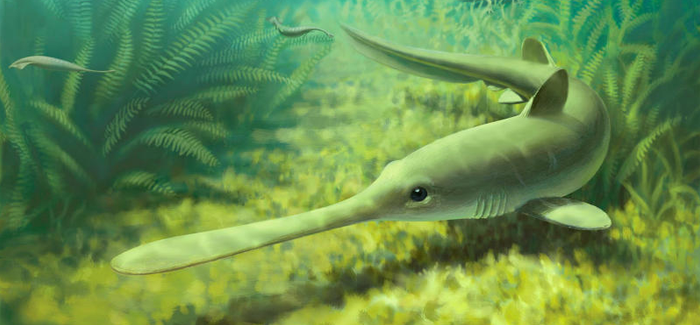
Prehistoric Badringa was the first migratory shark. (Illustration by John Megahan/University of Michigan)
Prehistoric sharks that migrated like salmon, African Americans’ long commutes, babies’ nuanced social observations, and genetic findings that complicate the story of how dogs evolved from wolves.
Shark tales
In the backward days of Pangaea, Badringa sharks migrated like salmon in reverse, living as adults in freshwater swamps and heading to the coast to breed. Paleontologists Michael Coates, from the University of Chicago, and Lauren Sallan, SM’09, PhD’12, from the University of Michigan, analyzed 24 Badringa fossils previously categorized into two separate species—one a freshwater swamp dweller, the other inhabiting saltwater shallows—and concluded that the species’ differences were actually evidence of the earliest known shark migration. The sawfish-like Badringa, extinct for 30 million years, inhabited an ancient river delta system in today’s Upper Midwest, using its extended snout for suction feeding off of river floors. Coates and Sallan’s study was published in the January Journal of Vertebrate Paleontology.
Travel for work
Partly an ongoing legacy of racial segretation in American cities, African Americans spend more time commuting to work than any other group. According to Virginia Parks, associate professor in the School of Social Service Administration, the average urban two-way commute is about an hour, but for black workers it can be significantly longer. Parks analyzed 2011 census data and found that low-wage black workers’ commutes are an average of seven minutes longer each way than those of low-wage whites. That’s evidence, Parks says, of a “jobs-housing mismatch,” driven in part by segregation, as blacks must travel far out of their neighborhoods to find service and other jobs. Parks presented her research at the annual meeting of the American Association for the Advancement of Science in February.
Babywatch
Even at nine months old, babies can tell whether or not adults get along with each other. University of Chicago psychologists Amanda L. Woodward and Katherine D. Kinzler, believing that infants understand eating as a social activity, showed 64 nine-month-olds videos in which adults ate different foods and reacted positively or negatively, sometimes agreeing, sometimes disagreeing. Then the babies were shown videos in which the same adults either greeted each other in a friendly tone or turned away with a grunt. When the tone of those greetings did not match up with the adults’ previous agreement or disagreement over the food, babies expressed surprise by lingering longer on those videos. “This is some of the first evidence that young infants are tracking other people’s social relationships,” says Woodward. The study was published online September 23 in the Journal of Experimental Psychology: General.
Wolves let the dogs out
Dogs are commonly understood to have evolved from wolves domesticated by early farmers. But a January 16 PLoS Genetics study argues that modern wolves and dogs descended from a common ancestor between 11 and 16 millennia ago, when humans were still hunter-gatherers. An international team of researchers, including University of Chicago genetics professor John Novembre, compared genomes from two dog breeds, basenji from central Africa and dingo from Australia, to the genomes of three gray wolves from China, Croatia, and Israel, regions where dogs are believed to have originated. The researchers also sequenced a golden jackal genome, to serve as an out-group representing earlier divergence from wolves. To their surprise, they found that the dogs were most closely related to each other, rather than to the wolf lineages, and the wolves’ closest relatives were each other as well. This suggests that dogs and wolves both descended from an older wolf-like common ancestor. Analyzing genome-wide patterns of variation, the researchers concluded that dogs and wolves both suffered massive decreases in population after their divergence, and that early dogs—lacking the gene for starch digestion, critical for domestication because it helped dogs adapt to human agricultural diets—were more carnivorous than modern dogs.
